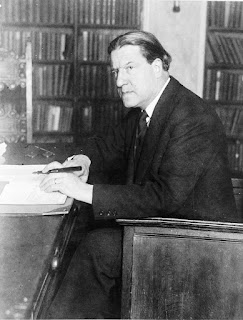
US bipartisan support for Israel -- when and how did that start?
Apparently, the birth of that bipartisan support for Israel came about during the term of Franklin Delano Roosevelt, despite FDR's antagonism towards Zionism.
 |
| FDR. Photo by Leon A. Perski, 1944. Source: Wikipedia |
And a lot of the credit seems to be due to Netanyahu.
In FDR’s Retreat on Zionism–and What it Means Today, Rafael Medoff writes about Roosevelt's attitude towards then-Palestine and Zionism.
Roosevelt opposed both, vigorously:
On January 17, 1943, on the question of restoring the pre-war equal rights of North Africa’s 330,000 Jews following the liberation of Casablanca, Roosevelt suggested that “the number of Jews engaged in the practice of the professions (law, medicine, etc) should be definitely limited to the percentage that the Jewish population in North Africa bears to the whole of the North African population,” so that local Arabs would not be angered.
Roosevelt also opposed settling Jewish refugees in North Africa: “I know, in fact, that there is plenty of room for them in North Africa but I raise the question of sending large numbers of Jews there...That would be extremely unwise.”
In April 1943, Roosevelt approved of a suggested Allied ban on all public discussion of Palestine until the end of the war. He backed down after Secretary of War Stimson called such a measure "alarmist"
On March 9, 1944, Roosevelt rejected the request of Rabbis Stephen S. Wise and Abba Hillel Silver to open Palestine to Jews fleeing Hitler. He claimed that the move would enrage Arabs and responded to them, “Do you want to start a Holy Jihad?”
 |
| Rabbi Stephen Samuel Wise; Library of Congress portrait. Wikipedia |
 |
| Abba Hillel Silver; excerpt from YouTube video |
Also in 1944, Republican Senator Robert Taft introduced a resolution affirming US support for the creation of a Jewish national home in Palestine. In response, Roosevelt claimed that the resolution would be “responsible for the death of a hundred thousand men.” As a result, the resolution was table for a year, and when Congress passed it – there was no Arab rioting.
Yet despite all this, the same Roosevelt who rejected a request by the Palestine (Jewish) Symphony Orchestra to name one of its theaters the “Roosevelt Amphitheatre” for fear it would link him too closely the Zionists -- did in fact turn around and support Zionism.
To a degree.
In the fall of 1943, it appeared that the Republican contender in the 1944 presidential election would go after the Jewish vote.
A major factor in adapting a strong pro-Zionist plank at the Republican National Convention was Netanyahu -- Benzion Netanyahu, the father of Israel's current prime minister.
 |
| Benzion Netanyahu in 2007. Source: Wikipedia |
Medoff writes:
Benzion Netanyahu, scholar and activist (and father of the current prime minister) arrived in the United States in 1940 as an emissary of Revisionist Zionism, the militant wing of the Zionist movement, headed by Vladimir Ze’ev Jabotinsky. Netanyahu organized rallies and authored full-page newspaper advertisements challenging the Roosevelt administration for abandoning European Jewry and the Zionist cause.The efforts of Netanyahu -- and Rabbi Abba Hillel Silver -- resulted in the inclusion of the following in the Republican platform :
Netanyahu also spent part of his time on Capitol Hill. In an interview with this author, Netanyahu recalled the political landscape he encountered in the nation’s capital: “Most of the Jewish and Zionist leaders, led by Rabbi Stephen Wise, were devoted Democrats and supporters of President Roosevelt. The idea of having friendly relationships with Republicans was inconceivable to them.” In the months prior to the June 1944 Republican National Convention, Netanyahu did the inconceivable–he took his case to GOP leaders, including former president Herbert Hoover; Senator Robert Taft, who was chairing the convention’s resolutions committee; and the influential Connecticut congresswoman Clare Booth Luce, who was slated to deliver the keynote address at the convention and would also serve on the resolutions committee. Netanyahu’s goal was to have the GOP platform include a plank supporting Jewish statehood in Palestine. Neither party had ever before taken such a stand.
In order to give refuge to millions of distressed Jewish men, women and children driven from their homes by tyranny, we call for the opening of Palestine to their unrestricted immigration and land ownership, so that in accordance with the full intent and purpose of the Balfour Declaration of 1917 and the resolution of a Republican Congress in 1922, Palestine may be reconstituted as a free and democratic commonwealth. We condemn the failure of the President to insist that the Palestine Mandatory carry out the provisions of the Balfour Declaration and the Mandate while he pretends to support them.In response, Rabbi Wise felt forced to try to get the Democrats, with Roosevelt's approval, to include a pro-Zionist statement in its platform as well.
To a large degree he was successful. The Democratic platform supported the “unrestricted Jewish immigration and colonization” of Palestine as well as the establishment of “a free and democratic Jewish commonwealth.”
One could argue that this was the beginning of the bi-partisan support for Israel that despite its ups and downs continues to this day.
Medoff writes:
Wise summed up what was achieved: “With the plank in both platforms the thing is lifted above partisanship.” The adoption of the two party planks ensured that support for Zionism, and later Israel, would become a permanent part of American political culture. No subsequent Republican or Democratic convention could go back on it without significant electoral ramifications.Despite the questions that are raised today about the extent and degree of Democratic support for Israel, that bi-partisan support does in fact continue.
As does the tendency of Netanyahu's not to quietly acquiesce to US policy towards Israel.

 Elder of Ziyon
Elder of Ziyon





















